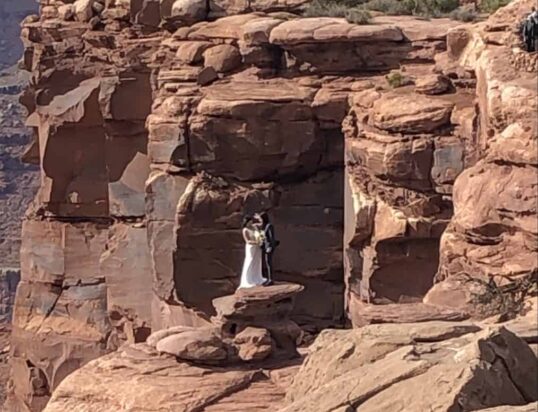“Get away from that edge,” a woman warned my husband. He and I were part of a group living on the edge, touring Canyonlands, one of the five national parks we’d view in Utah over the next few days. The voice belonged to a woman in our group who admitted she had anxiety issues about heights. I’m not much better.
I cautiously take two steps and peer over the edge. If someone stumbled, they’d tumble down more than a 1,000 feet. I feel weak in the knees. Just one little misstep or a ledge that weakens and crumbles and a person would crash to their death. Hair-tingling shivers would occur far too frequently.
Later that day, at Utah’s Dead Horse State Park, I watch a bride in a flowing wedding dress climb a tall rock pinnacle. I hold my breath the whole while. Once she seems secure, her groom begins scrambling up and my heart pounds again. They say their vows, promising to honor one another “until death do us part.” What is it that makes people want to test the limits?
I suspect that bride and groom, standing atop the rock pillar, felt a rush of confidence and empowerment. They also had the distinction of leaving their guests, a handful of people who applauded from the trail, with a wedding they would remember.
My research reveals that people are dying—literally— on a regular basis in search of the perfect photo to post on Facebook or Instagram. People dart in front of trains, leaping from rooftop to rooftop, and walk out on narrow ledges. During our tour, a young woman asked my husband to take her picture. He agreed. She explained that she “did this thing.” She turned her back to the camera, walked out on a ledge, and held up two fingers. I held my breath and tried to distract myself while my husband positioned the camera.
Did this young woman also enjoy extreme sports like paragliding. Did she like Halloween and scary movies? I had recently rewatched Play Misty For Me, a suspenseful movie I’d enjoyed many years ago. I was safe in my living room while Clint Eastwood and I lived—and survived— through a nightmare. At the conclusion, I was left with a gratifying sense of relief and well-being. I suspect those feelings are behind the reasons people take risks.
The picture taken and the young woman now on safer ground, I think about all the people this Halloween who will pay to be scared in attractions such as haunted houses. My daughter worked for Dungeon of Horrors in the Dells twenty-some years ago. In return, they got a gratifying sense of relief at the end to know they’d survived the ordeal. To them, it was money well spent.
Of course, not everyone appreciates being scared. In my daughter’s case, she had enjoyed her “monster” job, scary movies, and books such as Silence of the Lambs until she became a mother. After that—probably due to the worry, anxiety, and responsibility of caring for children—she was less keen on adding more stress to her life.
My husband and I are finishing our hike when two boys, maybe 8 and 10, horse around near the ledge. The older boy darts toward the younger. He sidesteps and whirls around to face his brother and the ledge. I break out into a cold sweat. My knees grow weak, and I feel a heart-pounding adrenaline rush.
Get away from that edge!


4 Replies to “Hair-tingling Shivers”
Leave it to you to bring on the fearsome and scary just in time for Halloween! Another homerun, Amy. I really liked the way you you looked behind the curtain to consider why some people push the boundaries of safety.
Thanks for the comment, Gayle. I appreciate hearing what makes a hit, and it helps me plan future columns. Be safe.
Why do we take risks? I read about a new business where you pay to destroy TV sets and cars. . They feel exhilarated. It’s better than video games but is it?
Fascinating! I certainly wouldn’t pay to have their experience but I imagine some would. I don’t understand it. Thanks for the comment, Sue.